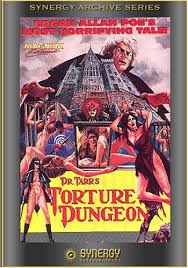Gaston LeBlanc (Arthur Hansel) is a 19th century journalist. He persuades his editor to let him do a story on a famous but remote mental hospital in the mountains of France. The hospital is run by a Dr. Maillard and is notorious for its revolutionary treatments in mental illness. Gaston persuades his friend Julien Couvier (Martin LaSalle), who lives near the asylum, to accompany him on his journey. Julien brings his cousin Blanche (Monica Serna), a gentlewoman of delicate upbringing.
Julien tells Gaston that Dr. Maillard normally refuses to see visitors, but Gaston is counting on winning over the recluse. When they get to the gates of the sanitarium, they are stopped by some strangely acting guards. Blanche is uncomfortable so Julien leaves with her. Gaston is taken to see Dr. Maillard.
Gaston is introduced to Dr. Maillard (Claudio Brook) and his niece, Eugenie (Ellen Sherman). Gaston is given a tour of the sanitarium and what Maillard refers to as his “soothing system” of care. Gaston notices that many of the patients seem to have the run of the estate. At first Gaston is impressed with the institution, but the longer he stays the stranger things appear. That night Gaston begins to realize that the man calling himself Dr. Maillard is an imposter and really one of the inmates. He flees.
In the meantime, Julien and Blanche, along with their coach driver, Henri (Jorge Bekris) are attacked by inmates from the sanitarium, Blanche is raped and the other two are tied up and tortured. Julien escapes for a while. Gaston finds Eugenie being prepared for sacrifice by a fake priest (David Silva). After saving Eugenie, he ends up running into Gaston in the woods. Before they can escape the grounds of the sanitarium they are recaptured and taken back to the asylum to be sacrificed.
“Dr. Tarr’s Torture Dungeon” AKA “The Mansion of Madness” AKA “La mansión de la locura” was released in 1973 and was directed by Juan Lopez Moctezuma. It is a Mexican gothic horror movie and a dark comedy. The film was loosely based on the 1845 story “The System of Doctor Tarr and Professor Fether” by Edgar Allan Poe.
Surrealist artist, Leonora Carrington is credited with designing the sets and costumes. Unfortunately, the film is very dark so trying to see Ms. Carrington’s vision is difficult. Still, the beginning and ending credits have a dreamlike vibe that looks a lot like watching one of those 3-D movies from the 50’s but without wearing the 3-D glasses.
Even though the film was a Mexican production, with a mostly Mexican cast and crew, the film was shot in English. It was then dubbed into Spanish for the Mexican market. It is Mexican filmmakers telling an American story, that takes place in France.
I know the film is supposed to be artistic, but most of it is pretty Whack-o. The acting is over-the-top, but it’s supposed to be. Looking at the movie as just a horror movie, it looks rather ridiculous. If you’re into avant-garde, then you may see a lot more here than just people running around acting silly or spouting lofty soliloquies. How much depends on how literary you are.
The fake Dr. Maillard talks about the real Dr. Maillard’s method called the “soothing system” for inmate care, but his method is the “Dr. Tarr and Professor Fether” method. This refers to the practice of Tar and Feathering people. This was a brutal form of punishment usually meted out by vigilantes. The criminal was covered in hot tar and rolled in feathers. They were then paraded through the streets to further humiliate the person.


